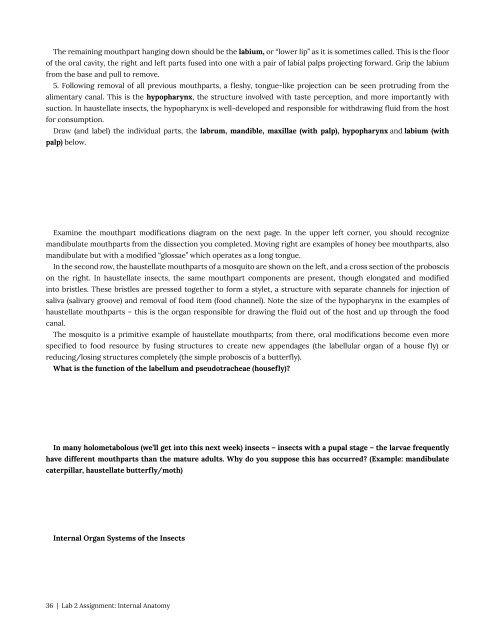Entomology 311 Lab Manual - 1st Edition, 2019
Entomology 311 Lab Manual - 1st Edition, 2019
Entomology 311 Lab Manual - 1st Edition, 2019
You also want an ePaper? Increase the reach of your titles
YUMPU automatically turns print PDFs into web optimized ePapers that Google loves.
The remaining mouthpart hanging down should be the labium, or “lower lip” as it is sometimes called. This is the floor<br />
of the oral cavity, the right and left parts fused into one with a pair of labial palps projecting forward. Grip the labium<br />
from the base and pull to remove.<br />
5. Following removal of all previous mouthparts, a fleshy, tongue-like projection can be seen protruding from the<br />
alimentary canal. This is the hypopharynx, the structure involved with taste perception, and more importantly with<br />
suction. In haustellate insects, the hypopharynx is well-developed and responsible for withdrawing fluid from the host<br />
for consumption.<br />
Draw (and label) the individual parts, the labrum, mandible, maxillae (with palp), hypopharynx and labium (with<br />
palp) below.<br />
Examine the mouthpart modifications diagram on the next page. In the upper left corner, you should recognize<br />
mandibulate mouthparts from the dissection you completed. Moving right are examples of honey bee mouthparts, also<br />
mandibulate but with a modified “glossae” which operates as a long tongue.<br />
In the second row, the haustellate mouthparts of a mosquito are shown on the left, and a cross section of the proboscis<br />
on the right. In haustellate insects, the same mouthpart components are present, though elongated and modified<br />
into bristles. These bristles are pressed together to form a stylet, a structure with separate channels for injection of<br />
saliva (salivary groove) and removal of food item (food channel). Note the size of the hypopharynx in the examples of<br />
haustellate mouthparts – this is the organ responsible for drawing the fluid out of the host and up through the food<br />
canal.<br />
The mosquito is a primitive example of haustellate mouthparts; from there, oral modifications become even more<br />
specified to food resource by fusing structures to create new appendages (the labellular organ of a house fly) or<br />
reducing/losing structures completely (the simple proboscis of a butterfly).<br />
What is the function of the labellum and pseudotracheae (housefly)?<br />
In many holometabolous (we’ll get into this next week) insects – insects with a pupal stage – the larvae frequently<br />
have different mouthparts than the mature adults. Why do you suppose this has occurred? (Example: mandibulate<br />
caterpillar, haustellate butterfly/moth)<br />
Internal Organ Systems of the Insects<br />
36 | <strong>Lab</strong> 2 Assignment: Internal Anatomy


















